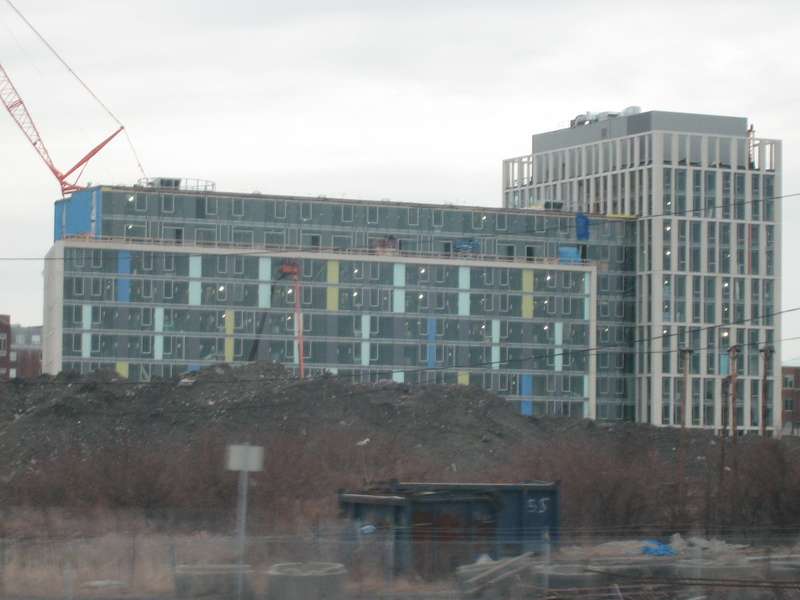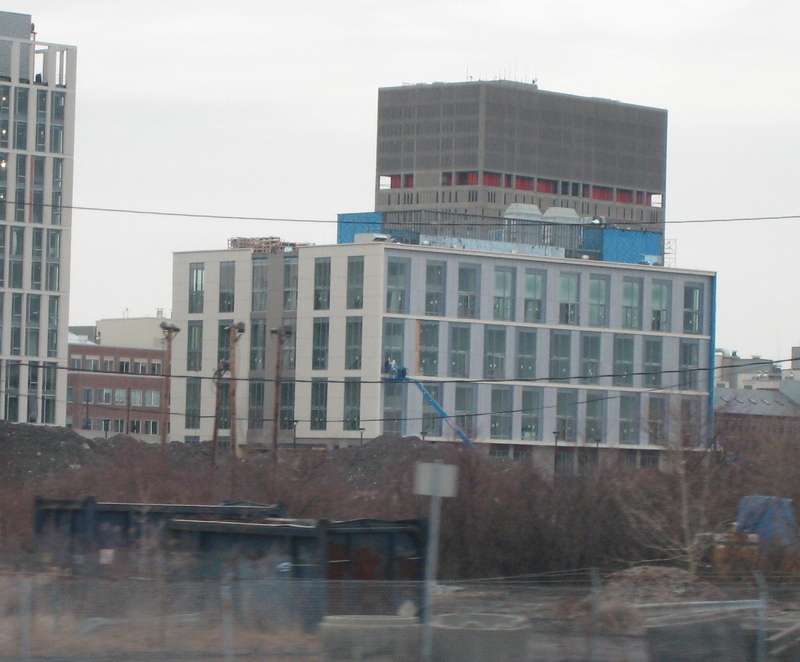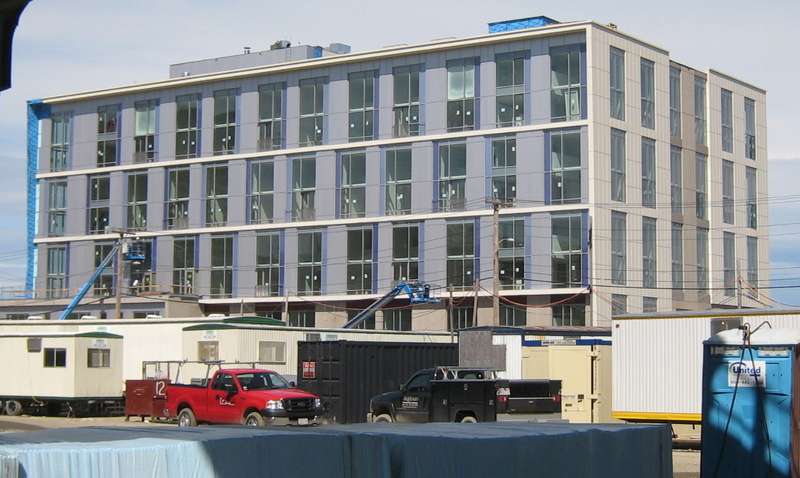You are using an out of date browser. It may not display this or other websites correctly.
You should upgrade or use an alternative browser.
You should upgrade or use an alternative browser.
Cambridge Crossing (NorthPoint) | East Cambridge/Charlestown | Cambridge/Boston
- Thread starter awood91
- Start date
briv
Senior Member
- Joined
- May 25, 2006
- Messages
- 2,083
- Reaction score
- 3
DarkFenX said:Does anyone know what is that brown brutalist building in the background on the 3rd photo.
That is the Middlesex County Courthouse/Jail.
briv said:DarkFenX said:Does anyone know what is that brown brutalist building in the background on the 3rd photo.
That is the Middlesex County Courthouse/Jail.
Those cells on top must have great views
ZenZen said:That is actually Mass. Eye and Ear Infirmary.
Please tell us you are joking. That is definitely the courthouse/jail, there is no argument about it. The MEEI is in Boston, abutting MGH
TheBostonian
Active Member
- Joined
- May 25, 2006
- Messages
- 348
- Reaction score
- 1
The MEEI is in the background of the 4th image.
- Joined
- May 25, 2006
- Messages
- 7,034
- Reaction score
- 1,874
What the fuck is with all the beige in this city!!!!!
Padre Mike
Active Member
- Joined
- Jan 27, 2007
- Messages
- 681
- Reaction score
- 1
vanshnookenraggen said:What the fuck is with all the beige in this city!!!!!
It's kind of like computers....until recently hardware was contained in beige boxes. Ugh! In Boston I think the beige is supposed to evoke sandstone trim. The white/grey evokes granite. And red evokes our tempers when builders/architects seem incapable of moving beyond stone colored facades. In San Francisco, I remember a series of apartments that were very modern, very clean and very colorful. The tinted facades were playful and offered a relief from the monochromatic street scene. In Boston we still seem to think that defaulting to brick red, granite grey and sandstone brown, while signature tones for the city (they look good on cloudy days), is our only choice.
Padre Mike said:vanshnookenraggen said:What the fuck is with all the beige in this city!!!!!
It's kind of like computers....until recently hardware was contained in beige boxes. Ugh! In Boston I think the beige is supposed to evoke sandstone trim. The white/grey evokes granite. And red evokes our tempers when builders/architects seem incapable of moving beyond stone colored facades. In San Francisco, I remember a series of apartments that were very modern, very clean and very colorful. The tinted facades were playful and offered a relief from the monochromatic street scene. In Boston we still seem to think that defaulting to brick red, granite grey and sandstone brown, while signature tones for the city (they look good on cloudy days), is our only choice.
Its because people would complain if you put up a big pink building, like in Miami or Brazil.
For example take this building, which is pink. It also seems to lack windows for some reason, but has a cool 3D effect where the flat wall seems to have texture. Would you like it in Boston?
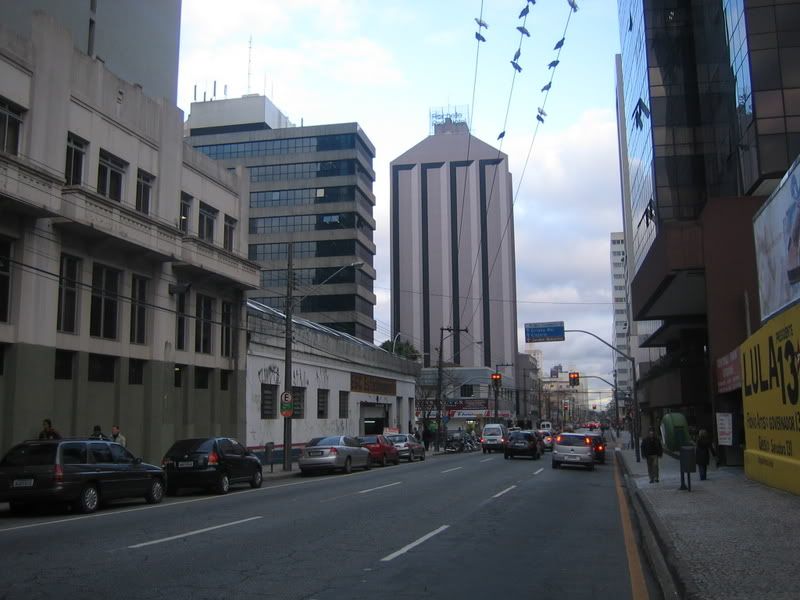
Something I think the city does need is more individual apartment buildings. As in, one family per floor, like this
(even though it is beige)
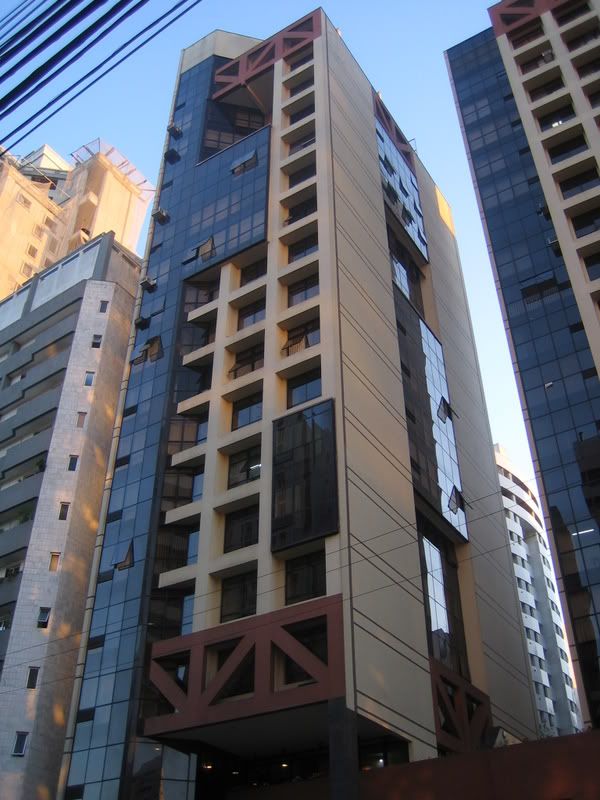
Charlie_mta
Senior Member
- Joined
- Jul 15, 2006
- Messages
- 4,563
- Reaction score
- 6,491
In the first photo of kz1000ps post, the blue and yellow insulation panels look kinda cool. Why not have panels of that color scheme on the exterior wall? It would break up the beige juggernaut a bit.
- Joined
- May 25, 2006
- Messages
- 7,034
- Reaction score
- 1,874
jass said:Something I think the city does need is more individual apartment buildings. As in, one family per floor, like this
(even though it is beige)

I don't know what or where that is but I think it is beyond cool.
Padre Mike
Active Member
- Joined
- Jan 27, 2007
- Messages
- 681
- Reaction score
- 1
I love that building too! The beige is not such a turn off because of the mix of glass and metal...and the fabulous design. The pink building...well, the color's not the problem...neither is the 3-D effect. It's the size of the blank wall that is tedious. Too bad they didn't paint a mural as we find on the brutalist BAC building on Newbury St.
vanshnookenraggen said:I don't know what or where that is but I think it is beyond cool.
lukewarm?
GLOBE EDITORIAL
All wet on NorthPoint
April 11, 2007
IN EAST CAMBRIDGE last week construction crews were working on the interiors of two condominium buildings, the first to go up in the massive NorthPoint project. This important development and others on filled marshland are jeopardized by an unexpected Supreme Judicial Court ruling earlier this year. Now the Legislature is considering a bill proposed by Governor Patrick that would end this uncertainty. The Legislature's response to the bill will say much about its willingness to set sensible development policies.
The Supreme Judicial Court ruled in February that state environmental regulators overstepped their authority in 1990 when they exempted filled tidelands that do not abut the water from Chapter 91 -- the law that mandates public benefits for development along the Massachusetts coast. The court said that only the Legislature could authorize these exemptions.
The Association of Cambridge Neighborhoods discerned this flaw in the implementation of Chapter 91 and brought the lawsuit. Now the Legislature must act, without harming the coastal environment or the climate of economic competitiveness in Massachusetts.
Members of the Cambridge group don't like NorthPoint, but the ruling has implications far beyond East Cambridge. It affects development on 4,000 acres in the state, three-quarters of them in Boston, including the Back Bay, the South Boston waterfront, the North Station area, and center field at Fenway Park. Much of this land is a long way from the waterfront.
If the Legislature does not act to clarify the law, landowners throughout these areas might have difficulties in selling or arranging financing on their properties unless they obtain a Chapter 91 environmental certificate. That's a waste of their time and that of environmental regulators. Representative Marty Walz of the Back Bay wants to amend the governor's proposal so that it would apply only to buildings occupied at the date of the Supreme Judicial Court ruling, while the Legislature assesses its options. "I don't think we have to rush to judgment here," she said last week. "We are not in a crisis situation."
Walz's proposal would not offer relief to projects like NorthPoint, which are already being built, or those approved by local authorities but not yet under construction, or those that are proceeding smoothly through the local approval process. The Committee on the Environment heard testimony Thursday from a developer near North Station, from an affordable housing advocate in Chinatown, from Boston city officials, and from Thomas McGee, senator from Lynn, that the ruling threatens to hold up financing and other preliminary work on important projects. The Legislature cannot let the ruling stand with only Walz's adjustment.
NorthPoint is the most compelling example of a project that should not be impeded as it moves toward full build-out. It will provide room for growth in an area that is already attractive to the high-tech jobs the state needs. The two condominium buildings are the first of 20 that will combine housing and office, laboratory, and commercial space. As a community benefit, the developers will rebuild the aging Lechmere MBTA station and move it a short distance to the east, where it will be in position for the extension of the Green Line to Somerville and Medford.
The project has been fully permitted by Cambridge and is awaiting final approval by Somerville, but it has attracted opposition at this late date for varied reasons. Some people think it should offer more public amenities. Others think it should better address the flooding problems in the area; others hope for a return of the Miller's River, which was filled in decades ago to provide land for rail yards; others think the new Lechmere station should be better connected to the rest of East Cambridge. Opponents hope to use the Chapter 91 process to win concessions.
NorthPoint developers have already agreed to build a 5.5-acre park and bicycle trail that will extend across the site and connect under the Gilmore Bridge to public open space on the Charles River. The park is being designed as part of an innovative system to move groundwater from Cambridge and Somerville through the project and into two 30-inch pipes that will empty into the Lechmere Canal. Some of that water would have flowed into Miller's River long ago, and the developers are doing their share to compensate for its loss. Restoration of the river is probably too costly to be practicable.
As for the T station, the developers have pledged to help redesign busy Monsignor O'Brien Highway so that it is friendlier to pedestrians. They are confident that this package of benefits would be enough to satisfy Chapter 91 requirements, but with the first condominiums scheduled to be occupied in the fall, there is no reason to force them over more regulatory hurdles.
NorthPoint is a prime example of a "smart growth" development because of its transit-friendly, urban location. It would be economic folly for the Legislature to gut the governor's bill. The Legislature might decide to study the implication of the ruling on future projects, but those now in the pipeline -- especially those already permitted by local authorities -- ought to be allowed to proceed without delay.
Link
All wet on NorthPoint
April 11, 2007
IN EAST CAMBRIDGE last week construction crews were working on the interiors of two condominium buildings, the first to go up in the massive NorthPoint project. This important development and others on filled marshland are jeopardized by an unexpected Supreme Judicial Court ruling earlier this year. Now the Legislature is considering a bill proposed by Governor Patrick that would end this uncertainty. The Legislature's response to the bill will say much about its willingness to set sensible development policies.
The Supreme Judicial Court ruled in February that state environmental regulators overstepped their authority in 1990 when they exempted filled tidelands that do not abut the water from Chapter 91 -- the law that mandates public benefits for development along the Massachusetts coast. The court said that only the Legislature could authorize these exemptions.
The Association of Cambridge Neighborhoods discerned this flaw in the implementation of Chapter 91 and brought the lawsuit. Now the Legislature must act, without harming the coastal environment or the climate of economic competitiveness in Massachusetts.
Members of the Cambridge group don't like NorthPoint, but the ruling has implications far beyond East Cambridge. It affects development on 4,000 acres in the state, three-quarters of them in Boston, including the Back Bay, the South Boston waterfront, the North Station area, and center field at Fenway Park. Much of this land is a long way from the waterfront.
If the Legislature does not act to clarify the law, landowners throughout these areas might have difficulties in selling or arranging financing on their properties unless they obtain a Chapter 91 environmental certificate. That's a waste of their time and that of environmental regulators. Representative Marty Walz of the Back Bay wants to amend the governor's proposal so that it would apply only to buildings occupied at the date of the Supreme Judicial Court ruling, while the Legislature assesses its options. "I don't think we have to rush to judgment here," she said last week. "We are not in a crisis situation."
Walz's proposal would not offer relief to projects like NorthPoint, which are already being built, or those approved by local authorities but not yet under construction, or those that are proceeding smoothly through the local approval process. The Committee on the Environment heard testimony Thursday from a developer near North Station, from an affordable housing advocate in Chinatown, from Boston city officials, and from Thomas McGee, senator from Lynn, that the ruling threatens to hold up financing and other preliminary work on important projects. The Legislature cannot let the ruling stand with only Walz's adjustment.
NorthPoint is the most compelling example of a project that should not be impeded as it moves toward full build-out. It will provide room for growth in an area that is already attractive to the high-tech jobs the state needs. The two condominium buildings are the first of 20 that will combine housing and office, laboratory, and commercial space. As a community benefit, the developers will rebuild the aging Lechmere MBTA station and move it a short distance to the east, where it will be in position for the extension of the Green Line to Somerville and Medford.
The project has been fully permitted by Cambridge and is awaiting final approval by Somerville, but it has attracted opposition at this late date for varied reasons. Some people think it should offer more public amenities. Others think it should better address the flooding problems in the area; others hope for a return of the Miller's River, which was filled in decades ago to provide land for rail yards; others think the new Lechmere station should be better connected to the rest of East Cambridge. Opponents hope to use the Chapter 91 process to win concessions.
NorthPoint developers have already agreed to build a 5.5-acre park and bicycle trail that will extend across the site and connect under the Gilmore Bridge to public open space on the Charles River. The park is being designed as part of an innovative system to move groundwater from Cambridge and Somerville through the project and into two 30-inch pipes that will empty into the Lechmere Canal. Some of that water would have flowed into Miller's River long ago, and the developers are doing their share to compensate for its loss. Restoration of the river is probably too costly to be practicable.
As for the T station, the developers have pledged to help redesign busy Monsignor O'Brien Highway so that it is friendlier to pedestrians. They are confident that this package of benefits would be enough to satisfy Chapter 91 requirements, but with the first condominiums scheduled to be occupied in the fall, there is no reason to force them over more regulatory hurdles.
NorthPoint is a prime example of a "smart growth" development because of its transit-friendly, urban location. It would be economic folly for the Legislature to gut the governor's bill. The Legislature might decide to study the implication of the ruling on future projects, but those now in the pipeline -- especially those already permitted by local authorities -- ought to be allowed to proceed without delay.
Link
- Joined
- May 25, 2006
- Messages
- 7,034
- Reaction score
- 1,874
Finally someone says something smart about development. NIMBY's are the reason we can't have nice things.
This editorial, along with one about Boston having the worst waterfront, makes me question the effectiveness of Chapter 91. It seems to me one of those bills that looks better on paper
This editorial, along with one about Boston having the worst waterfront, makes me question the effectiveness of Chapter 91. It seems to me one of those bills that looks better on paper
stellarfun
Senior Member
- Joined
- Dec 28, 2006
- Messages
- 5,711
- Reaction score
- 1,544
Doesn't anybody read the Herald? Nearly noon and no one has posted this?
The spat sounds pretty serious.
The spat sounds pretty serious.
Legal battle could mean NorthPoint?s headed south
By Scott Van Voorhis
Boston Herald Business Reporter
Friday, May 4, 2007
There is no bigger development project in the Boston area than Cambridge?s multibillion-dollar NorthPoint.
But a nasty legal battle has erupted between NorthPoint?s would-be developers, raising questions about the future of this long-planned ?city within a city? near the banks of the Charles River.
Boston and Maine railroad, which owns the 45-acre site on the East Cambridge-Boston line, has filed suit in Suffolk Superior Court against its longtime development partners, which include some of the biggest names in Boston real estate.
The railroad, and its parent company, Pan Am Railways, wants to give walking papers to its erstwhile partners, who include executives from the old Spaulding & Slye, long Boston?s blue chip real estate firm, as well as the global giant that recently acquired it, Jones Lang LaSalle.
The battle comes on the heels of a devastating Supreme Judicial Court ruling, one expected to force NorthPoint to undergo a lengthy Chapter 91 coastal building review.
The railroad company brought in the Spaulding & Slye team to handle development details of the project, but now accuses them of failing to get the job done.
A spokesman for Jones Lang LaSalle, whose role he said was limited to that of a real estate services provider, said the company had met all its obligations.
But the latest legal battle threatens to pull the plug on the sweeping development plan - one that had promised to transform old railway land into thousands of badly needed housing units.
Construction has begun on two condo high-rises, but now, according to the suit, ?the project has been essentially shut down.?
Moreover, after six and a half years of public relations hot air about NorthPoint, little if anything has been accomplished, the suit contends. That would likely come as a shock to anyone following some of NorthPoint?s glowing local press coverage. The project?s marketers have been trumpeting a steady barrage of progress on the 20-building behemoth that would even include a relocated T station.
However, behind all that happy talk has been a knock-down, drag-out fight over how to deal with some very serious - and expensive - obstacles.
A key part of the plan involved relocating the Lechmere Green Line station across the McGrath highway and into the planned NorthPoint development. In exchange for paying for this, the railway company was to receive more land in the area on which to build out NorthPoint. But plans to relocate the T station are now close to collapse amid spiraling costs, according to the suit.
The only construction that has happened so far - two partially completed condo buildings - was wholly financed by a principal of the railway company, the suit contends.
Ouch.
But this just about sums it up: ?Through six and one-half years of the Project, no appreciable progress has been made toward the ultimate goal.?
Still, it could be worse. Just ask the developer of Boston?s Fan Pier, now 25 years in the making.

